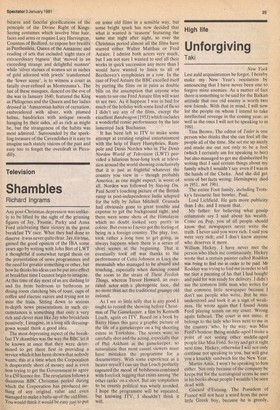Art
Treasure trove
John McEwen
Treasures from Chatsworth: the Devonshire Inheritance (Royal Academy till 11 January) is a most satisfying exhibition: not too large, not too crammed with masterpieces, not too specialised. There are pictures old and slap-up-to-date, drawings architectural and old masterly, miniatures, prints, designs for court masques by Inigo Jones, manuscripts, letters, books, silver, gold, jewellery, guns, furniture, sculpture and china, all of it meted out in small, exquisite portions like nouvelle cuisine. The catalogue a sturdy, thankfully matt, production is excellent value at £6.50. Short of a visit to Chatsworth, which obviously the exhibition seeks to promote, it is impossible to imagine the experience being improved upon.
Among the pictures there are several examples by the grandest masters Rembrandt, Poussin, a cut-down and debatable Velasquez but it is English painters who catch the eye. The most familiar image is probably Reynolds's famously informal portrait of the most celebrated 18th-century Devonshire duchess, Georgians, in mourning dress for her father, but finding a happy distraction in dandling her baby daughter on her knee. Nearby, a lovely half-length celebrates the beauty of her lifelong best friend, Lady Elizabeth Foster, also her husband's mistress and Georgiana's eventual successor. A couple of other oil sketches further whet the appetite for the full-scale Reynolds exhibition scheduled to take place at the Academy in 1983. Van Dyck is hardly less well represented by a superb full-length of Arthur Goodwin MP, a canvas deemed too fragile to travel when this exhibition toured America; and, demonstrating the present Duke's continued patronage of the arts, the exhibition concludes with a fine series of portraits of current members of the family by Lucien Freud, both in his early precise and late painterly style. Among the drawings again liberally endowed with the works of such unchallenged masters as Leonardo, Raphael, Holbein, Rembrandt it is the Claude landscapes that are particularly worth seeking out, and the Inigo Jones stage and costume designs these perhaps most of all, because they not only constitute the only extant examples but also document surely the most strange theatrical productions ever staged in England.
The 'masques', contrived by Jones and Ben Jonson, were devised to express the ideas of James and Charles I. In the palmier days of James they tended to be elaborate allegories embodying the semiphilosophical speculations he delighted in; but under Charles, and as the Civil War approached, they became more and more bizarre and fanciful glorifications of the principle of the Divine Right of Kings. Seeing costumes which involve blue hair, faces and arms or require Lucy Harrington, Countess of Bedford, to expose her breasts as Penthesileia, Queen of the Amazons; and reading of sets that included 'eight stars of extraordinary bigness' that 'moved in an exceeding strange and delightful manner' while 'silver statues of women set in niches of gold adorned with jewels' transformed the 'lower scene', is to witness a court as fatally over-refined as Montezuma's. The last of these masques, danced on the eve of the war in January 1640, featured the King as Philogenes and the Queen and her ladies dressed in 'Amazonian habits of carnation, embroidered with silver, with plumed helms, bandrickes with antique swords hanging by their sides, all as rich as might be, but the strangeness of the habits was most admired.' Surrounded by the sparkling treasure of the Cavendishes it is easy to imagine such stately visions of the past and easy too to forget the overdraft in Piccadilly.



































 Previous page
Previous page